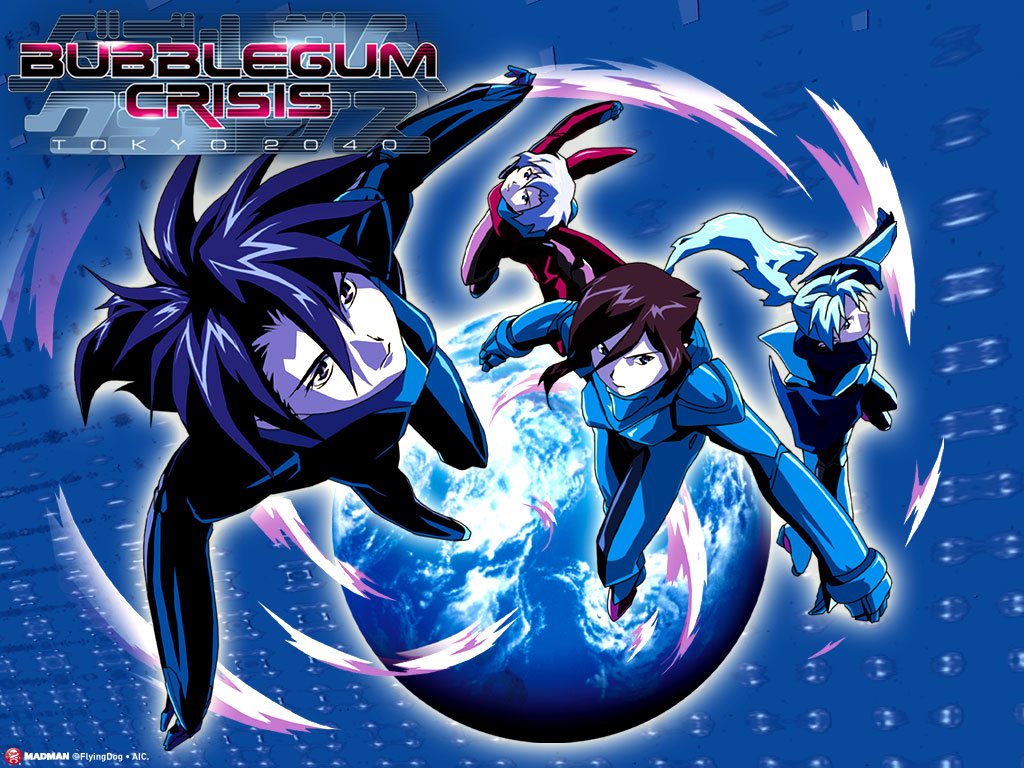 Let’s be clear: Bubblegum Crisis Tokyo 2040 isn’t a very good show in a lot of ways. At the same time, it’s also a wonderful show in ways that are intimately tied together with its flaws.
Let’s be clear: Bubblegum Crisis Tokyo 2040 isn’t a very good show in a lot of ways. At the same time, it’s also a wonderful show in ways that are intimately tied together with its flaws.
Like a lot of anime series from the late-1990s—like 1998’s Brain Powerd, as well as shows like Serial Experiments Lain and Gasaraki that featured BGCT2040 writer Chiaki J. Konaka—Bubblegum Crisis Tokyo 2040 exists under the shadow of Neon Genesis Evangelion.
Following its release in 1995, Evangelion had blown apart the model for what anime series were supposed to be and who they were for. As a result, a lot of the shows that emerged in its wake were staggering under the weight of their garbled, half-baked, heavy-handed political, philosophical and/or religious themes by the end of their run. However, it also meant that people who worked on these shows like Konaka had rather more freedom than creators of previous generations, whose work had been primarily targeted at kids.
Bubblegum Crisis Tokyo 2040 had another, much more obvious progenitor in the original Bubblegum Crisis OVA series, released sporadically between 1987 and 1991. That series set up the core concept of the Knight Sabers—four women in sexy powered armor, fighting robots called boomers (or voomers, depending on who you ask) and uncovering the sinister machinations of dubious megacorporation Genom. While the original series tended to focus on the ways the Knight Sabers interacted with people whose lives had been touched by boomers or Genom, the Tokyo 2040 incarnation mostly disregards the existence of the human population in favor of a deeper dive into the philosophical issues raised by the boomers themselves.
THE MAN MACHINE
As with the machine intelligences of all good dystopian sci-fi, the boomers of 2040 are going rogue, mutating into monstrous forms and generally causing a ruckus. Employed primarily in heavy labor and low-skilled service work, boomers are taken for granted at best and often mistreated by the humans they interact with, and the show invites the viewers to consider whether these incidents of boomers going postal might simply be a natural response any human would also have to the nature of their work and social status.
Robots have often been used as metaphors for slavery, but in BGCT2040 they also make (probably unintentional) parallels with immigration. While the Japan the show depicts seems on some level to be racially integrated (judging from their names, most of the main cast are at least mixed race), the show doesn’t deal with the issue in any direct way. Instead, the work boomers are seen doing in the Tokyo of 2040 is work that is increasingly being done by immigrants in present-day Tokyo. Working in factories, construction work and most visibly in recent years in convenience stores, it’s becoming increasingly common to encounter foreign faces around Tokyo. The comfort that Japanese people had been able to take from being able to look about and instinctively feel that people around them are thinking in the same way is being eroded. The way the camera lingers on the impassive face of a boomer evokes the discomfort of an unreadable alien face, its thought processes unknowable. Meanwhile, the taunting and abuse of service boomers by customers reflects the way the problem of so-called “monster customers” can be aggravated when the victim is also visibly “other.”
 POWER, CORRUPTION AND LIES
POWER, CORRUPTION AND LIES
BGCT2040 is a socially and politically conscious show, and one way this manifests itself is in the running background level of cynicism towards the media the show displays. Linna learns about the Knight Sabers from watching clips of their exploits online, while her coworker who only knows about the world from the TV news refuses to accept that they exist. As Tokyo is abandoned following an explosion of techno-carnage, the TV news babbles on inanely as if the problems were little more than a spot of intemperate weather. The tentacles of Genom are implied to reach deep into the media, and this subjugation of information channels to corporate interests seems an especially astute bit of prescience in the aftermath of the Fukushima nuclear disaster.
Genom’s tentacles reach further than the media, though: it’s their funding that allows the police’s dedicated anti-boomer force, the AD Police, to function. When the AD Police no longer serves their needs, Genom is able to have them abolished, leading to a police strike (a la Robocop). Interestingly, the Knight Sabers member embedded with the AD Police , Nene, isn’t a member of the union, and this reflects a broader way in which, despite the show’s political awareness, it holds its central characters aloof from those issues.
 I LOVE THE SOUND OF BREAKING GLASS
I LOVE THE SOUND OF BREAKING GLASS
The way Bubblegum Crisis Tokyo 2040 is most engaged with its social and political world is in how it deals with gender. Certainly, the show provides plenty of voyeuristic opportunities for teenage boys to ogle sexy cartoon women, and it’s not entirely clear why the Knight Sabers’ suits need to have high heels. Similarly, it’s not entirely clear why the female-coded boomers are all basically sexy-human in appearance and work in service industries, while the male-coded ones are mostly mechanical in form and work in heavy industry—is the show commenting on or simply embodying the objectification and fetishization of servile femininity? Also sidelined for some reason is detective Daley Wong’s homosexuality, which was a minor but surprisingly well-handled aspect of the OVA.
However, the way the Knight Sabers interact with the world as women is also where the show is at its best and most intelligent.
Priss is a lone wolf biker/rock star with little time for men, although her demeanor becomes visibly softer and more vulnerable around hunky mechanic Nigel. More significant in her case, though, is her relationship with cop Leon, who in BGCT2040 is changed from the easygoing character of the original series into a gruff, butch character overflowing with masculine rage. The arc of their relationship then plays out as a reverse Taming of the Shrew, where his attempts to woo Priss only begin to succeed when he is able to respect that she has powers and abilities that he doesn’t, and get over his own rage at being bested by a woman.
Linna is a former high school athlete from rural Kumamoto Prefecture, way off in far western Kyushu. Coming to Tokyo to work as an office lady, she has the most “normal” life of all the Knight Sabers. Still, her priorities and values often align in ways opposed to gender norms. While she is assiduously polite to service boomers, sexually harassing male chauvinist coworkers get a punch in the face. When her family try to set her up in an arranged marriage, she chooses her friends in Tokyo over the possibility of romantic happiness in Kyushu (and manages to get her rejected suitor to pay for her flight back while she’s at it). She will perform the social niceties society expects of her as a woman, but crucially she considers them only conditional on you treating her with the respect she deserves.
In the original OVAs, there was always a contrast between Nene’s computer skills and the ditzy way she came across. In Tokyo 2040, however, those two aspects of her character are more intricately interwoven. She lazes about in her booth at work, eating snacks and playing video games because the work isn’t challenging enough to occupy her full attention. She is also very conscious of the way language (especially Japanese) embodies power relationships. Her cutesy turns of phrase nearly always serve a function of undermining authority figures—especially male ones like Leon. However, when Sylia’s younger brother Mackie uses a casual form of address on her Nene is quick to insist that he adopt the more proper form.
Sylia is a more complex character in this regard. As the owner of a lingerie business, she is depicted as encouraging women to express their sexuality and be proud of their bodies, even if her main motivation is to make money from them. Like Priss, she seems to be making (romantic) plans for Nigel, but unlike Priss, Sylia is always depicted visually in a powerful or even predatory role in the relationship. Used as a child in deeply abusive ways by her scientist father, and now carrying the burden of the Knight Sabers’ leadership, she lets a cool public face hide a darker side, knocking back booze and smashing bottles and glasses in fits of rage when no one’s looking.
What the Knight Sabers add up to is a self-reliant unit. There is one revealing scene in episode 21 where the girls are off fighting for the future of the world and we see the four main male characters—Leon, Nigel, Mackie and Sylia’s butler Meisho—watching helplessly as they leave. The Knight Sabers are “a team just for girls,” as Nene puts it, where men are accepted as helpers and tech support, but kept firmly in their place.
SHE’S LOST CONTROL
The latter third of the series is where it goes off the rails, and is the part where the strength of the original OVA in focusing on the human consequences of technology and corporate power become clearer in contrast.
The central drama of this final stretch centers on Sylia and her godlike, quasi-boomer entity “sister” Galatea. It’s revealed that the boomers’ core modules are derived from Sylia’s own brain, and that Galatea is also a creation of that same process. Galatea is an interesting case in the confused relationship male characters have with female power: first, Sylia’s father gives Galatea tremendous power but then refuses to let her use it; later, Genom executive Brian J. Mason helps her unleash that power, but still somehow believes he has to right to control it. Needless to say, Galatea has other ideas. By raising and challenging the idea that women can embody power but must not be permitted to wield it for themselves, the show could perhaps also raise some questions on a meta level about whose benefit the show’s central sexy robo-suit fighting girls are really working for.
Unfortunately, this is also where the show descends into a spiral of plot-defiant cosmic goo, stretched over way too many episodes. The script loses any use for many of its central characters, inexplicably leaving Sylia behind for the fight against her sister, then losing interest in Linna and Nene in favor of a climax that centers on Priss – a character with no particular emotional relationship with Galatea for the drama to spark off, and with none of her teammates present to provide drama of their own.
 THIS IS POP?
THIS IS POP?
For all its flaws towards the end of the series, Bubblegum Crisis Tokyo 2040 is an interesting document of its era.
Like the original OVA, it wears its pop cultural influences on its sleeve. Names inherited from the original like Leon and Priss nod to Blade Runner, while every episode draws its title from a song or album out of your dad’s record collection (Deep Purple win with three episodes, but Steely Dan, The Doobie Brothers, Jimi Hendrix, The Doors, Sting and Dutch prog rock weirdos Focus all make appearances) in a way similar to, but slightly less cool than, fellow 1998 anime Cowboy Bebop. The show adds to the dated rock vibe by bookending its ad breaks with trashy MTV-style idents accompanied by cheesy guitar licks. Eagle-eyed indie rock kids might also spot that Mackie appears to be a Smiths fan, with a coffee mug reading “Hand in Glove” visible on his dresser. Like in the OVA, Priss is a musician, and she often uses the language of the music scene, referring to her payment for Knight Sabers gigs as her “gyara” (guarantee).
The music of the show itself is almost uniformly terrible though, with Priss’ own songs having none of the anthemic, fist-pumping, puffy-haired ’80s rock charm of OVA songs like “Konya wa Hurricane” and “Mad Machine.” The show’s only real concession to good taste is a recurring instrumental piece late on in the series that shamelessly rips off “Roads” by trip hop legends Portishead.
Of course the influence of Evangelion is also strong. Shots of Linna staring at her hand in heightened contemplation echo similar scenes with Evangelion’s Shinji, while the launching tubes for the suits recall the Eva units’ launch sequences. The time limit on the suits’ batteries also seems to take its cues from Eva (which was perhaps itself borrowing a money-saving trick from Ultraman), and the emphasis on destroying the boomers by finding and destroying their core adds an Evangelion-esque element to the battles.
In this way, Bubblegum Crisis Tokyo 2040 is a rare bridging point of the 1980s OVA era and the post-Evangelion TV age, combining strong, Bechdel-compliant female lead characters, overwrought philosophical and religious symbolism, pop cultural shout-outs that reach beyond the world of anime, and an in-show world that reflects recognizable realities of Japanese social and political life.
Ian Martin is the author of Quit Your Band! Musical Notes from the Japanese Underground.







